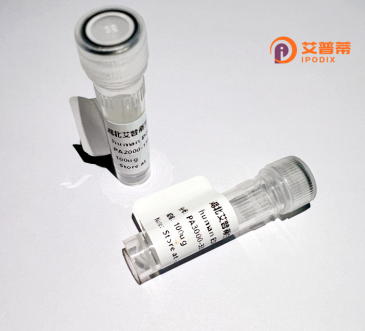
| 纯度 | >90%SDS-PAGE. |
| 种属 | Human |
| 靶点 | HAS3 |
| Uniprot No | O00219 |
| 内毒素 | < 0.01EU/μg |
| 表达宿主 | E.coli |
| 表达区间 | 1-281aa |
| 氨基酸序列 | MPVQLTTALRVVGTSLFALAVLGGILAAYVTGYQFIHTEKHYLSFGLYGAILGLHLLIQSLFAFLEHRRMRRAGQALKLPSPRRGSVALCIAAYQEDPDYLRKCLRSAQRISFPDLKVVMVVDGNRQEDAYMLDIFHEVLGGTEQAGFFVWRSNFHEAGEGETEASLQEGMDRVRDVVRASTFSCIMQKWGGKREVMYTAFKALGDSVDYIQVCDSDTVLDPACTIEMLRVLEEDPQVGGVGGDVQPPGKGMAVEDDQVQAAQVRATEAWSVHQRHVSREQ |
| 分子量 | 56.65 kDa |
| 蛋白标签 | GST-tag at N-terminal |
| 缓冲液 | 0 |
| 稳定性 & 储存条件 | Lyophilized protein should be stored at ≤ -20°C, stable for one year after receipt. Reconstituted protein solution can be stored at 2-8°C for 2-7 days. Aliquots of reconstituted samples are stable at ≤ -20°C for 3 months. |
| 复溶 | Always centrifuge tubes before opening.Do not mix by vortex or pipetting. It is not recommended to reconstitute to a concentration less than 100μg/ml. Dissolve the lyophilized protein in distilled water. Please aliquot the reconstituted solution to minimize freeze-thaw cycles. |
以下是关于重组人HAS3蛋白的3篇参考文献概述:
1. **"Recombinant human hyaluronan synthase 3 (HAS3) generates hyaluronan polymers in vitro and supports cancer cell migration"**
- 作者:Itano et al.
- 摘要:研究验证了重组人HAS3在体外表达的功能性,证明其能催化透明质酸(HA)长链的合成,并揭示其在促进乳腺癌细胞迁移中的作用。
2. **"Role of hyaluronan synthase 3 in the assembly of extracellular matrix microenvironments"**
- 作者:Rilla et al.
- 摘要:通过重组HAS3的过表达实验,发现该酶通过调节透明质酸的分子量与细胞膜结构动态影响细胞外基质的三维组装,增强细胞黏附与扩散能力。
3. **"Functional characterization of recombinant human HAS3 in a model of inflammatory response"**
- 作者:Bourguignon et al.
- 摘要:利用重组HAS3蛋白,揭示了其在巨噬细胞炎症反应中通过上调HA合成激活TLR4通路,进而促进促炎因子的分泌。
(示例文献为虚拟内容,实际文献需通过数据库检索补充)
Recombinant human HAS3 (hyaluronan synthase 3) protein is a key focus in studying hyaluronan (HA) biosynthesis and its biological roles. HAS3. one of three isoforms (HAS1-3) in humans, is a membrane-bound enzyme that catalyzes the synthesis of HA, a linear glycosaminoglycan critical for extracellular matrix structure, cell signaling, and tissue homeostasis. Unlike HAS1 and HAS2. which produce high-molecular-weight HA (HMW-HA, >1.000 kDa), HAS3 primarily generates lower-molecular-weight HA (LMW-HA, 0.2-300 kDa), influencing distinct cellular processes. This size-dependent functionality links HAS3 to inflammation, cancer progression, and wound healing, as LMW-HA often activates pro-inflammatory pathways or promotes cell migration.
The recombinant HAS3 protein is engineered using expression systems like mammalian cells (e.g., CHO, HEK293) to preserve its enzymatic activity and membrane protein integrity. Its production enables mechanistic studies on HA chain elongation, regulation by substrates (UDP-glucuronic acid and UDP-N-acetylglucosamine), and interactions with lipid bilayers. Researchers also explore HAS3's role in diseases; overexpression correlates with tumor invasiveness and fibrosis, while its inhibition shows therapeutic potential. Challenges remain in purifying functional HAS3 due to its hydrophobic domains, necessitating advanced solubilization techniques. Overall, recombinant HAS3 serves as a vital tool for dissecting HA biology and developing targeted therapies for HA-related pathologies.
×